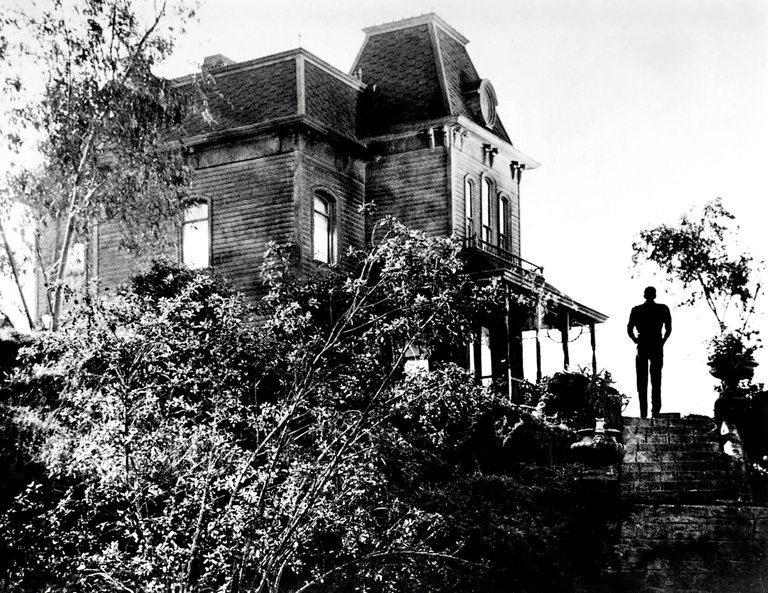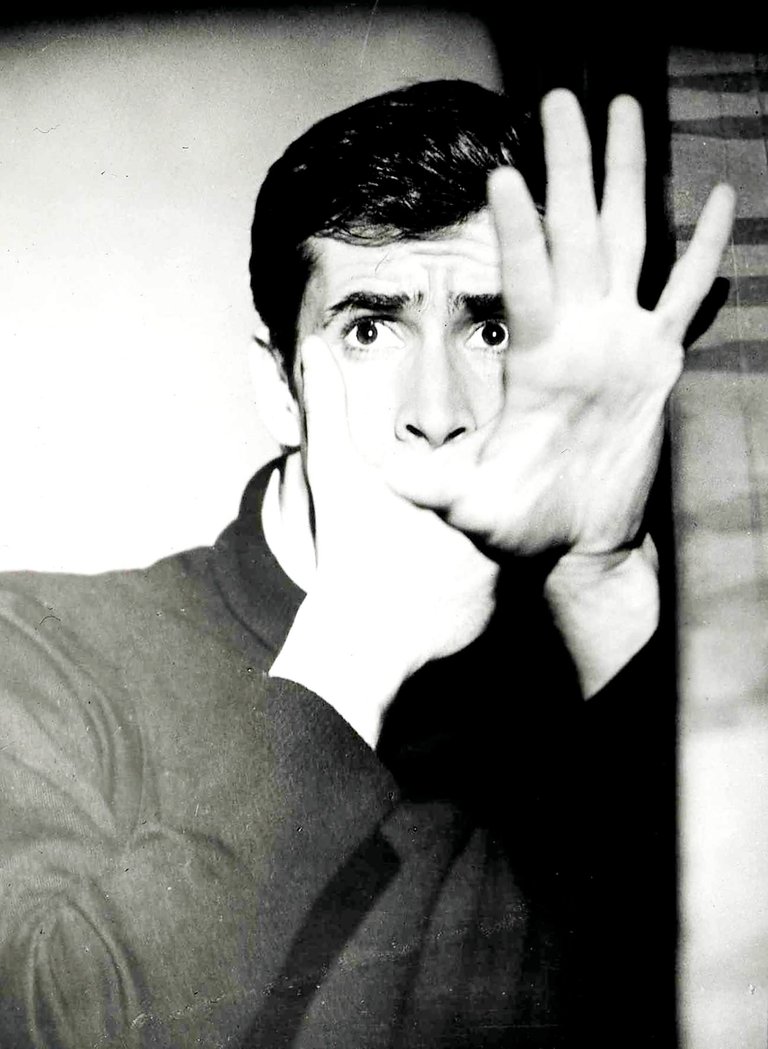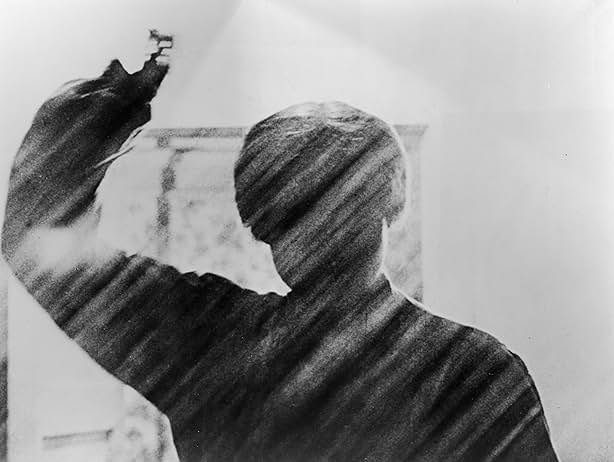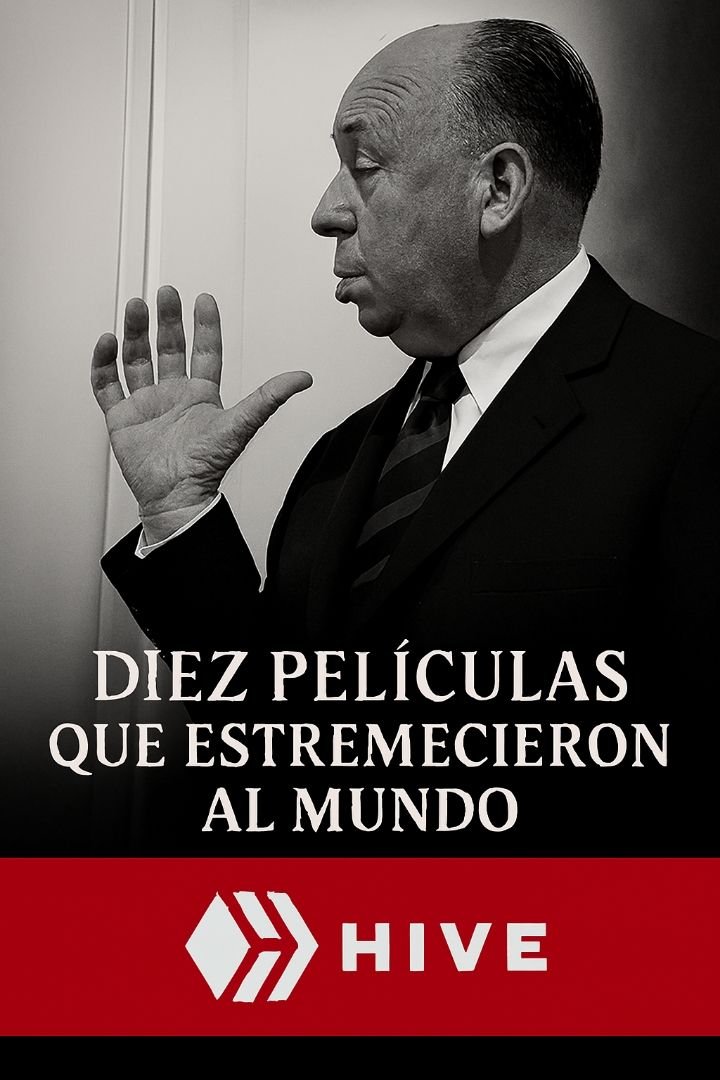🎞️ Psychosis. Shocking|REVIEW [ENG-ESP]

[...Those high-pitched, almost hysterical violins accompany the scene like a scream that doesn't come from the mouth, but from the depths of the mind. They are the echo of trauma, of unfolding, of inexplicable horror...]

Together again, film lovers in #hive
The screen shakes. The projector comes to life once more... this time to unveil the seventh film in my personal saga: "Ten Films That Shook the World".
Each frame is an earthquake. Each sequence, a turning point in the history of the seventh art. Prepare to dive into the abyss of visual narrative, where only the boldest, those that left an indelible scar on the collective consciousness, have their place.
The countdown has begun.
If you dare to cross over to the other side of the seat and discover which titles have earned a place in this film pantheon, the links at the end of this post are your ticket in.
The legend continues…
There are films that move us. Not because of what they show, but because of what they imply. Psycho (1960) is one of them. It doesn't matter whether the viewer trembles or remains impassive: the film settles in some corner of the memory, like a shadow that can't be fully explained. And that, while not always moving, does shake us.
I arrived at Psycho with a heavy backpack. I had read about Hitchcock, about the shower scene, about the narrative shift that supposedly changed cinema. I expected vertigo, tension, fear. What I found was something else: a film that doesn't seek shock, but rather a slow slide toward the unsettling. And while that approach is powerful, it also demands a different disposition from the viewer. It's not about feeling, but about observing. It's not about trembling, but about thinking.

The story begins with Marion Crane, a woman on the run after committing a robbery. Her arrival at the Bates Motel seems like a pause, but soon becomes the center of a spiral that never stops. The film presents Marion as the protagonist, following her, accompanying her, framing her. And just when one begins to build empathy, Hitchcock eliminates her. There's no warning. No preparation. Just a shower, a knife, music that cuts through the air. And suddenly, the story shifts.
That twist, which was revolutionary at the time, may seem like a narrative trick today. But it must be understood in context: Hitchcock broke with the logic of the hero, with the security of the classic story. By killing Marion, he destabilized the viewer. He left them without a guide. He forced them to look elsewhere: toward Norman Bates.

Norman is the heart of the film. Not for what he says, but for what he doesn't say. Anthony Perkins plays him with a mixture of shyness and menace that never resolves. His smile, his gestures, his voice… everything seems normal, but something doesn't fit. And that "something" is what sustains the tension. There is no visible monster. There is no excess blood. Just a presence that unfolds, that hides, that observes.
His relationship with his mother, or with the idea of his mother, is the symbolic axis of the film. The house on the hill, the fixed shots, the silences… everything builds an atmosphere that doesn't scream, but that throbs. And that murmur is more disturbing than any scream. Because you don't know where it comes from, or where it goes.

The much-discussed shower scene is more technical than emotional. The editing, the music, the black and white... everything is calculated. But it's not going for a cheap scare. It's going for bewilderment. The viewer doesn't see the knife penetrate, doesn't see red blood, doesn't see the killer's face. Only fragments. And those fragments are enough to suggest what isn't shown. That's Hitchcock's strength: he doesn't need to show to unsettle.
Bernard Herrmann's music is another character. Those high-pitched, almost hysterical violins accompany the scene like a scream that doesn't come from the mouth, but from the depths of the mind. They are the echo of trauma, of unfolding, of unexplained horror. And although at times they seem too present, too insistent, they fulfill their function: sustaining a tension that isn't always present in the image.
The ending, with its psychiatric explanation, may seem long. Today, accustomed to more ambiguous, more open endings, that monologue may feel like an over-explanation. But at the time, it was necessary. The audience needed to understand. They needed an answer. And Hitchcock, though a lover of mystery, also knew when to offer certainties.
Now, why did Psycho shock the world?

It wasn't the blood. It wasn't the fear. It was what it broke. What it inaugurated. What it insinuated. Hitchcock dismantled classical narrative, blurred the figure of the hero, and introduced psychological horror as a way of looking at the world. It was no longer about external monsters, but internal monsters. It was no longer about what you see, but what you imagine.
Psycho opened a door that cinema never closed again. After it, horror stopped being just screams and shadows. It became more complex, more intimate, more symbolic. Films like The Shining, The Silence of the Lambs, Hereditary… all draw from that source. They all understand that true fear isn't on the outside, but in what isn't said, in what is repressed, in what is hidden.
Seeing it today, after so many works have followed its path, can diminish its impact. Some narrative choices no longer surprise. The pace may seem slow. The tension, contained. But that doesn't diminish its merit. On the contrary: it reveals its elegance. Psycho doesn't need to scream to shock. It doesn't need blood to unsettle. Its horror is different. It's that of the splitting mind. That of a fragmented identity. That of repressed desire.
And while as a viewer, one may come away with a mixture of admiration and terror, the truth is that the film leaves a mark. Not because of what is felt, but because of what is thought. Not because of what is shown, but because of what is suggested. And that kind of shock, although more subtle, can be deeper. And it is.

Recommending it comes with a warning: don't expect pure fear. Don't expect a story that grips you from the first minute. Psycho is something else. It's a film that you think more than you feel. And that, depending on the moment and the viewer, can be a virtue... or a barrier.
But if you manage to cross that barrier, if you accept the game, if you enter into the logic of the film, then yes: Psycho shakes you. Not like a thunderclap, but like a whisper. Not like a blow, but like a crack. And that crack, even if you can't see it, remains.
That's why it's on my list of Ten Films That Shook the World. Not for what it made you feel, but for what it made you think. Not for what it showed, but for what it changed. Because after Psycho, cinema was never the same. And that, even if it's not immediately apparent, is shocking.

en español

🎞️ Psicosis. Estremecedor
[...Esos violines agudos, casi histéricos, acompañan la escena como un grito que no viene de la boca, sino del fondo de la mente. Son el eco del trauma, del desdoblamiento, del horror que no se explica...]

Juntos otra vez, amantes del cine en #hive
La pantalla se agita. El proyector cobra vida una vez más..., esra vez para develar la cinta número 7 de mi saga personal: «Diez películas que estremecieron al mundo».
Cada fotograma, es un terremoto. Cada secuencia, un parteaguas en la historia del séptimo arte. Prepárense para sumergirse en el abismo de la narrativa visual, donde solo las más audaces, las que dejaron una cicatriz imborrable en la conciencia colectiva, tienen su lugar.
La cuenta regresiva ha empezado.
Si se atreven a cruzar al otro lado de la butaca y descubrir qué títulos han conquistado un lugar en este panteón fílmico, los enlaces al final de este Post son su boleto de acceso.
La leyenda sigue…
Hay películas que nos atraviesan. No por lo que muestran, sino por lo que insinúan. Psicosis (1960) es una de ellas. No importa si el espectador tiembla o permanece impasible: la película se instala en algún rincón de la memoria, como una sombra que no se explica del todo. Y eso, aunque no siempre conmueva, sí estremece.
Llegué a Psicosis con la mochila cargada. Había leído sobre Hitchcock, sobre la escena de la ducha, sobre el giro narrativo que supuestamente cambió el cine. Esperaba vértigo, tensión, miedo. Lo que encontré fue otra cosa: una película que no busca el sobresalto, sino el deslizamiento lento hacia lo inquietante. Y aunque esa apuesta tiene fuerza, también exige del espectador una disposición distinta. No se trata de sentir, sino de observar. No se trata de temblar, sino de pensar.

La historia comienza con Marion Crane, una mujer que huye tras cometer un robo. Su llegada al motel Bates parece una pausa, pero pronto se convierte en el centro de una espiral que no se detiene. La película presenta a Marion como la protagonista, la sigue, la acompaña, la enmarca. Y justo cuando uno empieza a construir empatía, Hitchcock la elimina. No hay aviso. No hay preparación. Solo una ducha, un cuchillo, una música que corta el aire. Y de pronto, el relato cambia de eje.
Ese giro, que en su momento fue revolucionario, hoy puede parecer un truco narrativo. Pero hay que entenderlo en su contexto: Hitchcock rompió con la lógica del héroe, con la seguridad del relato clásico. Al matar a Marion, desestabilizó al espectador. Lo dejó sin guía. Lo obligó a mirar hacia otro lado: hacia Norman Bates.

Norman es el corazón de la película. No por lo que dice, sino por lo que calla. Anthony Perkins lo interpreta con una mezcla de timidez y amenaza que nunca se resuelve. Su sonrisa, sus gestos, su voz… todo parece normal, pero algo no encaja. Y ese “algo” es lo que sostiene la tensión. No hay monstruo visible. No hay sangre en exceso. Solo una presencia que se desdobla, que se esconde, que observa.
La relación con su madre, o con la idea de su madre, es el eje simbólico del filme. La casa en la colina, los planos fijos, los silencios… todo construye una atmósfera que no grita, pero que late. Y ese murmullo es más perturbador que cualquier alarido. Porque no se sabe de dónde viene, ni hacia dónde va.

La escena de la ducha, tan comentada, es más técnica que emocional. El montaje, la música, el blanco y negro… todo está calculado. Pero no busca el susto fácil. Busca el desconcierto. El espectador no ve el cuchillo penetrar, no ve sangre roja, no ve el rostro del asesino. Solo fragmentos. Y esos fragmentos son suficientes para sugerir lo que no se muestra. Esa es la fuerza de Hitchcock: no necesita mostrar para inquietar.
La música de Bernard Herrmann es otro personaje. Esos violines agudos, casi histéricos, acompañan la escena como un grito que no viene de la boca, sino del fondo de la mente. Son el eco del trauma, del desdoblamiento, del horror que no se explica. Y aunque en algunos momentos parecen demasiado presentes, demasiado insistentes, cumplen su función: sostener una tensión que no siempre está en la imagen.
El final, con su explicación psiquiátrica, puede parecer largo. Hoy, acostumbrados a cierres más ambiguos, más abiertos, ese monólogo puede sentirse como una sobreexplicación. Pero en su momento fue necesario. El público necesitaba entender. Necesitaba una respuesta. Y Hitchcock, aunque amante del misterio, también sabía cuándo ofrecer certezas.
Ahora bien, ¿por qué Psicosis estremeció al mundo?

No fue por la sangre. No fue por el miedo. Fue por lo que rompió. Por lo que inauguró. Por lo que insinuó. Hitchcock desarmó la narrativa clásica, desdibujó la figura del héroe, introdujo el horror psicológico como una forma de mirar el mundo. Ya no se trataba de monstruos externos, sino de monstruos internos. Ya no se trataba de lo que se ve, sino de lo que se imagina.
Psicosis abrió una puerta que el cine no volvió a cerrar. Después de ella, el terror dejó de ser solo gritos y sombras. Se volvió más complejo, más íntimo, más simbólico. Películas como El resplandor, El silencio de los corderos, Hereditary… todas beben de esa fuente. Todas entienden que el verdadero miedo no está en el exterior, sino en lo que no se dice, en lo que se reprime, en lo que se oculta.
Verla hoy, después de tantas obras que han seguido su camino, puede restarle impacto. Algunas decisiones narrativas ya no sorprenden. El ritmo puede parecer lento. La tensión, contenida. Pero eso no le quita mérito. Al contrario: revela su elegancia. Psicosis no necesita gritar para estremecer. No necesita sangre para inquietar. Su horror es otro. Es el de la mente que se desdobla. El de la identidad que se fragmenta. El del deseo que se reprime.
Y aunque como espectador uno pueda salir con una mezcla de admiración y terror, pero lo cierto es que la película deja huella. No por lo que se siente, sino por lo que se piensa. No por lo que se muestra, sino por lo que se sugiere. Y ese tipo de estremecimiento, aunque más sutil, puede ser más profundo. Y lo es.

Recomendarla implica una advertencia: no esperes miedo puro. No esperes una historia que te atrape desde el primer minuto. Psicosis es otra cosa. Es una película que se piensa más que se siente. Y eso, dependiendo del momento y del espectador, puede ser una virtud… o una barrera.
Pero si se logra cruzar esa barrera, si se acepta el juego, si se entra en la lógica del filme, entonces sí: Psicosis estremece. No como un trueno, sino como un susurro. No como un golpe, sino como una grieta. Y esa grieta, aunque no se vea, se queda.
Por eso está en mi lista entre las Diez películas que estremecieron al mundo. No por lo que hizo sentir, sino por lo que hizo pensar. No por lo que mostró, sino por lo que cambió. Porque después de Psicosis, el cine ya no fue igual. Y eso, aunque no se note a simple vista, es estremecedor.

SAGA (Reseñas)

📌 © Copyright 2025 Argenis Osorio. Todos los derechos reservados/© Copyright 2025 Argenis Osorio. All rights reserved
📌 Imágenes del sitio oficial de IMDb/Images from the official IMDb site
📌 Mi idioma nativo es el español, traduzco al inglés con Google Translation /My native language is Spanish, I translate to English with Google Translation

Soy autor de los libros de Narrativa: Convite de Cenizas (2002), Tras la piel (2004), En este lado de la muerte (2014), El orden natural de las cosas (2015), La Sangre del Marabú (2020), La Sexta Caballería de Kansas (2024) y La Nada Infinita (2024)


Consider following our trail on HIVEVOTE by clicking on the image below. We thank all our supporters.

To all of you artists out here at HIVE! If you ever are lost, please join Bokura No Digital World at our Discord chat.


💖 Thanks for supporting the #hueso movement with your post! 🦴 You received 1 Hueso token gift.
Luego de ver el filme, veíamos al asesino por todas partes, la psicosis fue una transmutación del autor a cada espectador. Aún veo esa escena como parte de algún hecho artístico y me produce los mismos miedos.
Excelente tu reseña 💜🤍
Gracias buena amiga. Las obras de arte genuinas tienen ese don de perdurar, de inquietar y conquistar.
🌻✍️
💜🤍
You received an upvote ecency
Gracias por el apoyo al arte verdadero que significa una cinta como esta. Me siento honrado ✍️
Amo la filmografía de Hitchcock y esta es, sobre todas, mi cinta favorita. Los remakes han sido buenos pero el encanto terrible de la obra original es imperecedero. Gracias por traer esta montaña en tu reseña también monumental
"El encanto terrible" me quedo con ese verso con la belleza de tu presencia @maiasun84 🌻✍️
Pues quédese con ello, amigo mío
[@PowerPaul:]
Hey! Because of your participation in the @CryptoCompany community and your participation in the "Banner for Boost" campaign you received a vote from your CryptoCompany and its trail! Thank you & Hive a great day!
Recent posting from @PowerPaul or the CryptoCompany network:
by @cryptocompany
by @yourfairy
by @powerpaul
by @powerpaul
Con la famosa escena de la ducha, fue la primera vez en que me fijé en el cómo se le podían mostrar las cosas al espectador. La carpintería, como dice uno de mis maestros.
El tema de la carpintería es vital. Sin dudas.
Gracias por llegar @africapg
🌻✍️
Gracias, una obra maestra del horror. Y como es propio de ellas, jamás pasa de moda y conservan su encanto.
No importa el tiempo, cuando la vuelves a ver el horror te va calando como la primera vez que la viste.
Eso solo lo hacen los maestros.
Absolutamente de acuerdo solo los maestros, los de verdad. Agradezco mucho tu entrada @camelia28 🌻✍️
Una película impactante que logró a la perfección su intención de perdurar en la mente de sus espectadores, cosa que hoy raramente puede ser dicha con sinceridad si hablamos de lo que se produce en la actualidad.
Tengo entendido que la escena de la ducha provocó cierta tensión entre Hitchcock y su esposa, pues cada uno la entendía a su manera. Creo que fue ella la que añadió la música, pero lo importante es el ícono que nos dejaron para la historia. Es cierto que cambió la forma de entender y hacer el cine de horror, de lo cual me alegro, pero creo que sería más justo decir que cambió la forma de hacer cine en general.